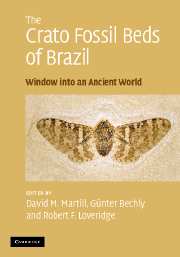Book contents
- Frontmatter
- Contents
- Contributors
- Preface
- Acknowledgements
- Part I The Crato Formation Konservat Lagerstätte
- 1 Introduction to the Crato Formation
- 2 The geology of the Crato Formation
- 3 Stratigraphy of the Crato Formation
- 4 The sedimentology and depositional environment of the Crato Formation
- 5 Commercial exploitation of the Crato Formation
- 6 Preparation techniques for Crato Formation fossils
- Part II The invertebrate fauna
- Part III The vertebrate fauna
- Part IV The flora
- Part V Miscellanea
- Appendix: species list for the Crato Formation
- Systematic index
- Plate section
- References
6 - Preparation techniques for Crato Formation fossils
Published online by Cambridge University Press: 22 August 2009
- Frontmatter
- Contents
- Contributors
- Preface
- Acknowledgements
- Part I The Crato Formation Konservat Lagerstätte
- 1 Introduction to the Crato Formation
- 2 The geology of the Crato Formation
- 3 Stratigraphy of the Crato Formation
- 4 The sedimentology and depositional environment of the Crato Formation
- 5 Commercial exploitation of the Crato Formation
- 6 Preparation techniques for Crato Formation fossils
- Part II The invertebrate fauna
- Part III The vertebrate fauna
- Part IV The flora
- Part V Miscellanea
- Appendix: species list for the Crato Formation
- Systematic index
- Plate section
- References
Summary
Fossils are abundant throughout the Nova Olinda Member of the Crato Formation and occur at most levels within the laminated parts of the sequence. They occur in a variety of styles of preservation depending on the degree of weathering of the deposit and, to a lesser degree, on localized diagenetic anomalies. Accordingly, a number of different techniques are employed for their preparation depending on the nature of the matrix and on the style of preservation of the fossil itself. In general, all fossils from the Nova Olinda Member are fragile, being composed of either a soft, sometimes powdery goethite in the buff-coloured weathered stone, or a powdery carbonaceous material in the fresh blue-grey limestones. Many fossils are discovered when the limestone is split along well-defined bedding planes, resulting in the splitting of the fossil into two halves, often referred to as part and counterpart. Such discoveries, while damaging the fossil, may reveal details of the internal anatomy and, in the case of larger examples of the fish Dastilbe, may reveal stomach contents. Such fossils often require little or no preparation.
Many Crato fossils, however, occur beneath several laminae and are discovered, often by the quarry workers, as almost imperceptible swellings on bedding-plane surfaces (Figure 6.1c). These slight swellings may be accompanied by whitening of the surface, and occasionally a halo of orange-brown goethite (Figure 6.1c). Such fossils may lie at depths of more than 10 mm (Figure 6.1d) and always require mechanical preparation to expose them.
- Type
- Chapter
- Information
- The Crato Fossil Beds of BrazilWindow into an Ancient World, pp. 70 - 76Publisher: Cambridge University PressPrint publication year: 2007



